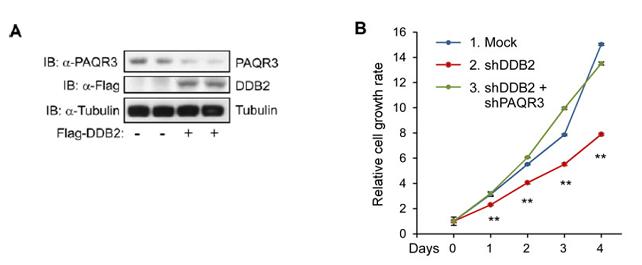DDB2 (damage-specific DNA-binding protein 2) is the product of the XPE (xeroderma pigmentosum group E) gene. DDB2 forms an E3 ligase complex with DDB1 (damage-specific DNA-binding protein 1) and CUL4A (cullin 4A) and plays a critical part in nucleotide excision repair. Gastric cancer is the fifth most common malignancy and the third leading cause of cancer death worldwide with poor prognosis and limited treatment options. Gastric cancer development is a multistep process involving deregulation of many oncogenic pathways. A research team led by Prof. CHEN Yan at the Institute for Nutritional Sciences, Shanghai Institutes for Biological Sciences (SIBS), demonstrated that DDB2 can regulate tumorgenesis of gastric cancer cells through modulation of PAQR3 (progestin and adipoQ receptor family member III) ubiquitination and degradation. Previous work by CHEN’s group has identified PAQR3 as a tumor suppressor which is down-regulated in many types of human cancers. This study showed that DDB2 is involved in ubiquitination and degradation of PAQR3. Overexpression of DDB2 can elevate the degradation and ubiquitination of PAQR3 and reduce the protein level of PAQR3. After knockdown DDB2, the protein level of PAQR3 is increased and the ERK and PI3K/AKT pathways are inhibited. The cell proliferation rate and migration of gastric cancer cells are inhibited by DDB2 knockdown and such effects are abrogated by PAQR3 knockdown. In general, DDB2 is a post-translational regulator of PAQR3, and the effect of DDB2 on the gastric cancer cells is mediated by PAQR3. The work, entitled “DDB2 is involved in ubiquitination and degradation of PAQR3 and regulates tumorigenesis of gastric cancer cells”, was published online in Biochemical Journal on June 11th , 2015. This work was supported by research grants from the Ministry of Science and Technology of China and the National Natural Science Foundation of China. 
Fig. 1. DDB2 antagonizes the tumor suppressive activity of PAQR3. A. Overexpression of DDB2 decreases the PAQR3 protein level. B. Cell proliferation of AGS cells was affected by DDB2 and PAQR3. An MTT assay was performed to detect the cell proliferation rate of the AGS cells infected with different shRNA-containing lentiviruses as indicated. (Image by Prof. CHEN Yan's team) |

